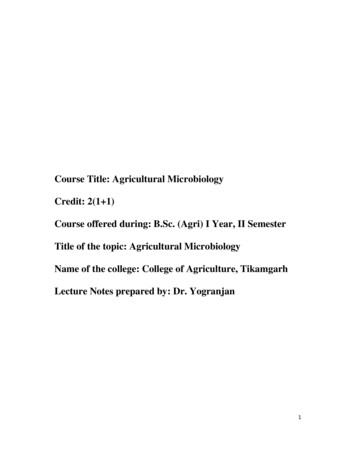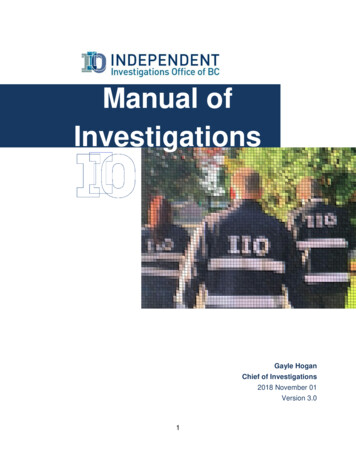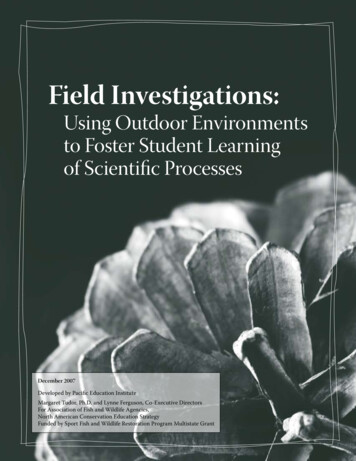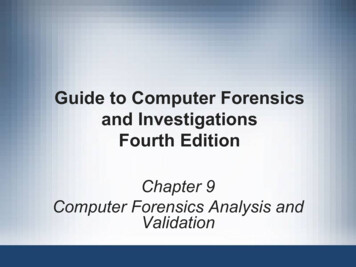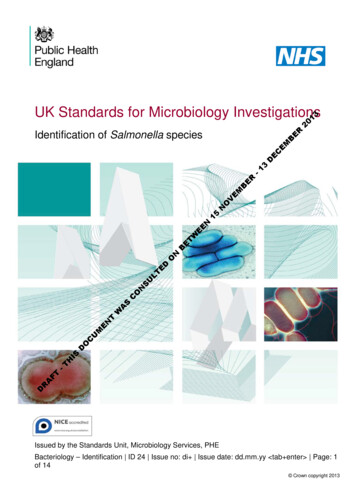
Transcription
R2013UK Standards for Microbiology EEN15NOVEMBER-13DECEMBEIdentification of Salmonella speciesIssued by the Standards Unit, Microbiology Services, PHEBacteriology – Identification ID 24 Issue no: di Issue date: dd.mm.yy tab enter Page: 1of 14 Crown copyright 2013
Identification of Salmonella speciesAcknowledgments13UK Standards for Microbiology Investigations (SMIs) are developed under theauspices of Public Health England (PHE) working in partnership with the NationalHealth Service (NHS), Public Health Wales and with the professional organisationswhose logos are displayed below and listed on the websitehttp://www.hpa.org.uk/SMI/Partnerships. SMIs are developed, reviewed and revisedby various working groups which are overseen by a steering committee ER20The contributions of many individuals in clinical, specialist and reference laboratorieswho have provided information and comments during the development of thisdocument are acknowledged. We are grateful to the Medical Editors for editing themedical content.-13DFor further information please contact us at:EN15NOVEMBERStandards UnitMicrobiology ServicesPublic Health England61 Colindale AvenueLondon NW9 5EQE-mail: standards@phe.gov.ukWEWebsite: ULTEDONBETUK Standards for Microbiology Investigations are produced in association with:Bacteriology – Identification ID 24 Issue no: di Issue date: dd.mm.yy tab enter Page: 2 of 22UK Standards for Microbiology Investigations Issued by the Standards Unit, Public Health England
Identification of Salmonella speciesContentsACKNOWLEDGMENTS . 2AMENDMENT TABLE . 4UK STANDARDS FOR MICROBIOLOGY INVESTIGATIONS: SCOPE AND PURPOSE . 513SCOPE OF DOCUMENT . 8R20INTRODUCTION . 8EMBETECHNICAL INFORMATION/LIMITATIONS . 9SAFETY CONSIDERATIONS . 92TARGET ORGANISMS . 103IDENTIFICATION . 104IDENTIFICATION OF SALMONELLA SPECIES FLOWCHART. 165REPORTING . 176REFERRALS. 187NOTIFICATION TO PHE OR EQUIVALENT IN THE DEVOLVEDADMINISTRATIONS CONSULTEDREFERENCES . 20Bacteriology – Identification ID 24 Issue no: di Issue date: dd.mm.yy tab enter Page: 3 of 22UK Standards for Microbiology Investigations Issued by the Standards Unit, Public Health England
Identification of Salmonella speciesAmendment TableEach SMI method has an individual record of amendments. The current amendmentsare listed on this page. The amendment history is available fromstandards@phe.gov.uk.5/dd.mm.yy tab enter Issue no. discarded.2.2Insert Issue no.#.# tab enter Section(s) involvedAmendment-13DECEMBER20Amendment No/Date.13New or revised documents should be controlled within the laboratory in accordancewith the local quality management system.VEMBERDocument has been transferred to a new templateto reflect the Health Protection Agency’s transitionto Public Health England.NOFront page has been redesigned.EN15Status page has been renamed as Scope andPurpose and updated as appropriate.EWhole document.BETWProfessional body logos have been reviewed andupdated.Scientific content remains unchanged.4/21.10.11NTWAmendment No/Date.ASCONSULTEDONStandard safety and notification references havebeen reviewed and updated. – remove if notappropriateUMEIssue no. discarded.2.2DOCInsert Issue no.2.1Amendment-THISSection(s) involvedAFTWhole document.Some references updated.DRReferences.Document presented in a new format.Bacteriology – Identification ID 24 Issue no: di Issue date: dd.mm.yy tab enter Page: 4 of 22UK Standards for Microbiology Investigations Issued by the Standards Unit, Public Health England
Identification of Salmonella speciesUK Standards for Microbiology Investigations#:Scope and PurposeUsers of SMIsSMIs are primarily intended as a general resource for practising professionalsoperating in the field of laboratory medicine and infection specialties in the UK. SMIs provide clinicians with information about the available test repertoire andthe standard of laboratory services they should expect for the investigation ofinfection in their patients, as well as providing information that aids theelectronic ordering of appropriate tests. SMIs provide commissioners of healthcare services with the appropriatenessand standard of microbiology investigations they should be seeking as part ofthe clinical and public health care package for their population.-13DECEMBER2013 ERBackground to SMIs15NOVEMBSMIs comprise a collection of recommended algorithms and procedures covering allstages of the investigative process in microbiology from the pre-analytical (clinicalsyndrome) stage to the analytical (laboratory testing) and post analytical (resultinterpretation and reporting) stages.EDONBETWEENSyndromic algorithms are supported by more detailed documents containing adviceon the investigation of specific diseases and infections. Guidance notes cover theclinical background, differential diagnosis, and appropriate investigation of particularclinical conditions. Quality guidance notes describe laboratory processes whichunderpin quality, for example assay validation.CONSULTStandardisation of the diagnostic process through the application of SMIs helps toassure the equivalence of investigation strategies in different laboratories across theUK and is essential for public health surveillance, research and development activities.ASEqual Partnership WorkingMENTWSMIs are developed in equal partnership with PHE, NHS, Royal College ofPathologists and professional societies.DRAFT-THISDOCUThe list of participating societies may be found athttp://www.hpa.org.uk/SMI/Partnerships. Inclusion of a logo in an SMI indicatesparticipation of the society in equal partnership and support for the objectives andprocess of preparing SMIs. Nominees of professional societies are members of theSteering Committee and Working Groups which develop SMIs. The views of nomineescannot be rigorously representative of the members of their nominating organisationsnor the corporate views of their organisations. Nominees act as a conduit for two wayreporting and dialogue. Representative views are sought through the consultationprocess.SMIs are developed, reviewed and updated through a wide consultation process.#Microbiology is used as a generic term to include the two GMC-recognised specialties of Medical Microbiology (which includesBacteriology, Mycology and Parasitology) and Medical Virology.Bacteriology – Identification ID 24 Issue no: di Issue date: dd.mm.yy tab enter Page: 5 of 22UK Standards for Microbiology Investigations Issued by the Standards Unit, Public Health England
Identification of Salmonella speciesQuality AssuranceNICE has accredited the process used by the SMI Working Groups to produce SMIs.The accreditation is applicable to all guidance produced since October 2009. Theprocess for the development of SMIs is certified to ISO 9001:2008.EMBER2013SMIs represent a good standard of practice to which all clinical and public healthmicrobiology laboratories in the UK are expected to work. SMIs are NICE accreditedand represent neither minimum standards of practice nor the highest level of complexlaboratory investigation possible. In using SMIs, laboratories should take account oflocal requirements and undertake additional investigations where appropriate. SMIshelp laboratories to meet accreditation requirements by promoting high qualitypractices which are auditable. SMIs also provide a reference point for methoddevelopment.EMBER-13DECThe performance of SMIs depends on competent staff and appropriate qualityreagents and equipment. Laboratories should ensure that all commercial and in-housetests have been validated and shown to be fit for purpose. Laboratories shouldparticipate in external quality assessment schemes and undertake relevant internalquality control procedures.NOVPatient and Public InvolvementNBETWEEN15The SMI Working Groups are committed to patient and public involvement in thedevelopment of SMIs. By involving the public, health professionals, scientists andvoluntary organisations the resulting SMI will be robust and meet the needs of theuser. An opportunity is given to members of the public to contribute to consultationsthrough our open access website.EDOInformation Governance and EqualityONSULTPHE is a Caldicott compliant organisation. It seeks to take every possible precautionto prevent unauthorised disclosure of patient details and to ensure that patient-relatedrecords are kept under secure conditions.OCUMENTWASCThe development of SMIs are subject to PHE Equality Aweb C/1317133470313. The SMIWorking Groups are committed to achieving the equality objectives by effectiveconsultation with members of the public, partners, stakeholders and specialist interestgroups.ISDLegal StatementDRAFT-THWhilst every care has been taken in the preparation of SMIs, PHE and any supportingorganisation, shall, to the greatest extent possible under any applicable law, excludeliability for all losses, costs, claims, damages or expenses arising out of or connectedwith the use of an SMI or any information contained therein. If alterations are made toan SMI, it must be made clear where and by whom such changes have been made.The evidence base and microbial taxonomy for the SMI is as complete as possible atthe time of issue. Any omissions and new material will be considered at the nextreview. These standards can only be superseded by revisions of the standard,legislative action, or by NICE accredited guidance.SMIs are Crown copyright which should be acknowledged where appropriate.Bacteriology – Identification ID 24 Issue no: di Issue date: dd.mm.yy tab enter Page: 6 of 22UK Standards for Microbiology Investigations Issued by the Standards Unit, Public Health England
Identification of Salmonella speciesSuggested Citation for this OVEMBER-13DECEMBER2013Public Health England. (YYYY tab enter ). Identification of Salmonella species. UKStandards for Microbiology Investigations. ID 24 Issue di .http://www.hpa.org.uk/SMI/pdf.Bacteriology – Identification ID 24 Issue no: di Issue date: dd.mm.yy tab enter Page: 7 of 22UK Standards for Microbiology Investigations Issued by the Standards Unit, Public Health England
Identification of Salmonella speciesScope of DocumentThis SMI describes the identification of Salmonella species. The majority ofSalmonellae are isolated from faeces but the organism may be isolated from otherspecimens such as blood, bone marrow and urine.This SMI should be used in conjunction with other SMIs.2013IntroductionERTaxonomyR-13DECEMBThere are currently 2 validly published species and 6 subspecies. They areSalmonella bongori, Salmonella enterica and its subspecies - Salmonella entericasubsp arizonae, Salmonella enterica subsp diarizonae, Salmonella enterica subspenterica, Salmonella enterica subsp houtenae, Salmonella enterica subsp indica andSalmonella enterica subsp salamae1.EEN15NOVEMBEAll validly published names, even if they are not cited in the above list can still be usedby bacteriologists. These include Salmonella Enteritidis, Salmonella Paratyphi,Salmonella Typhi and Salmonella Typhimurium (even though they have been classedas serotypes). Salmonella subterranean was recently removed from the genusbecause it is closely related to Escherichia hermannii and does not belong to thegenus Salmonella1.LTEDONBETWThe nomenclature adopted in this SMI follows the advice from the JudicialCommission of the International Committee on Systematics of Prokaryotes2. It is likelyhowever, that laboratories will continue to report serotypes as species for some timeto come3.SUCharacteristicsHISDOCUMENTWASCONCells are rod-shaped, non-spore-forming, and predominantly motile by means ofperitrichous flagella with diameters of around 0.7 to 1.5 μm and lengths of 2 to 5 μmwith a few exceptions. On blood agar, colonies are 2-3mm in diameter. Colonies aregenerally lactose non-fermenters. They obtain their energy from oxidation andreduction reactions using organic sources, and are facultative anaerobes. Theyproduce acid from glucose usually with the production of gas, and are oxidasenegative3. Most produce hydrogen sulphide except Salmonella Paratyphi A andSalmonella Typhi, which is a weak producer. They are identified with a combination ofserological and biochemical tests.DRAFT-TSalmonella species are classified and identified into serotypes according to theKauffmann-White scheme4; there are more than 2,500 Salmonella serotypes that havebeen described and reported 5. Presently, new serotypes are being discovered eachyear, adding to the complexity of this large bacterial population. Primary subdivision isinto “O” serogroups (those which share a common somatic antigen), and these arethen subdivided on the basis of “H” (flagella) antigens4. Strains of Salmonella Typhimay produce Vi antigen, which is an acidic polysaccharide layer outside the cell wall.When fully developed, it renders the bacteria agglutinable with Vi antiserum andinagglutinable with “O” antiserum. Antigens similar to Vi may also be found in somestrains of Salmonella Paratyphi C and Salmonella Dublin.Bacteriology – Identification ID 24 Issue no: di Issue date: dd.mm.yy tab enter Page: 8 of 22UK Standards for Microbiology Investigations Issued by the Standards Unit, Public Health England
Identification of Salmonella speciesAll Salmonella serotypes are considered potentially pathogenic. Some serotypes arehost-specific, but the majority can affect different hosts. Most Salmonella serotypesexist in two phases: a motile phase I and a non-motile phase II. Cultures that are nonmotile upon primary culture may be switched to the motile phase using a Craigietube6.20REBSalmonella species are found in faeces, blood, bile, urine, food and feed andenvironmental materials.13Salmonella Enteritidis and Salmonella Typhimurium are the two most importantserotypes of salmonellosis transmitted from animals to humans in most parts of theworld. Salmonella Typhi and Salmonella Paratyphi A, B and C are the most commoncauses of enteric fever in humans.ECEMThe type species is Salmonella enterica.3DPrinciples of IdentificationO15NTechnical Information/LimitationsVEMBER-1Isolates are identified by a combination of colonial appearance, serology(agglutination with specific antisera) and biochemical testing. If confirmation ofidentification is required, isolates should be sent to the Reference Laboratory.EENQuality controlLTEDONBETWIf using commercially manufactured antisera, check suitability of use for all methods.Each new lot or shipment of antisera/commercial identification systems should betested and validated for positive and negative reactivity using known control strains;ensuring it is fit for purpose. Laboratories must follow manufacturer’s instructionswhen using these products.NSUAgglutination TestTWASCOFor slide agglutinations, growth on some solid media is not optimal for the formation offlagella. False negative results may be obtained with H antisera. Inoculation of thepure culture to a wet nutrient agar slope will aid flagellum formation.Safety Considerations7-23CUMEN1FT-THISDOMost Salmonella species are in Hazard Group 2 with important exceptions includingSalmonella Typhi and Salmonella Paratyphi A, B & C. All work on Salmonella Typhiand Salmonella Paratyphi A, B & C must be performed under Containment level 3conditions.DRASalmonella Typhi, and Salmonella Paratyphi A, B & C cause severe and sometimesfatal disease. The infectious dose varies with the serotype. Laboratory acquiredinfections have been reported- until 1974, 258 cases and 20 deaths due to laboratoryacquired typhoid fever were reported. 48 cases of salmonellosis were reported until1976. 64 cases and 2 deaths due to Salmonella spp. infections were reportedbetween 1979 and 2004, most of them associated with S. Typhi24-26 and a SalmonellaTyphi vaccination is available; guidance is given in the Department of Healthimmunisation policy27.Bacteriology – Identification ID 24 Issue no: di Issue date: dd.mm.yy tab enter Page: 9 of 22UK Standards for Microbiology Investigations Issued by the Standards Unit, Public Health England
Identification of Salmonella speciesRefer to current guidance on the safe handling of all Hazard Group 2 organismsdocumented in this SMI.Appropriate personal protective equipment (PPE) and techniques designed tominimise exposure of the laboratory workers should be worn and adhered to at alltime.REBEMThe above guidance should be supplemented with local COSHH and riskassessments.20Laboratory procedures that give rise to infectious aerosols must be conducted in amicrobiological safety cabinet.13The most effective method for preventing laboratory-acquired infections is theadoption of safe working practices.DECCompliance with postal and transport regulations is essential and should be verified.-13Target OrganismsER2OVEMBCommonest serotypes of Salmonella isolated and known to causeinfections in humansONBETWEEN15NSalmonella Enteritidis (1,9,12:g, m:-), Salmonella Typhimurium (1,4,5:i: 1,2),Salmonella Virchow (6,7:r: 1,2), Salmonella Hadar (6,8:z10: e, n, x), SalmonellaHeidelberg (1,4,5,12:r: 1,2), Salmonella Newport (6,8:e, h: 1,2), Salmonella Infantis(6,7:r: 1,5), Salmonella Agona (4,12:f, g, s:-), Salmonella Paratyphi A (1,2,12:a: 1,2),Salmonella Paratyphi B (1,4,5,12:b: 1,2), Salmonella Paratyphi C (6,7,Vi: c: 1,5),Salmonella Typhi (9,12,Vi: d:-)Identification3.1Microscopic AppearanceONSULTED3WEPrimary Isolation MediaM3.2NTGram negative rodsASCGram’s stain TP 39 - Staining ProceduresOCUBlood agar incubated in 5-10% CO2 at 35–37 C for 16-24hrs.ISDCLED agar incubated in air at 35–37 C for 16-24hrs.-THXLD agar incubated in air at 35–37 C for 16-24hrs.AFTDCA incubated in air at 35–37 C for 16-24hrs.DRBGA incubated in air at 35–37 C for 16-24hrs.Bacteriology – Identification ID 24 Issue no: di Issue date: dd.mm.yy tab enter Page: 10 of 22UK Standards for Microbiology Investigations Issued by the Standards Unit, Public Health England
Identification of Salmonella species3.3Colonial AppearanceBlood agar - Colonies are moist and 2-3mm in diameter.CLED agar - Salmonella species are lactose non fermenters (some serotypes e.g.Salmonella Arizonae and Salmonella Indiana may ferment lactose).13XLD agar – Colonies are red, and usually with a black centre (some serotypes e.g.Salmonella Paratyphi A and Salmonella Typhi may not produce a black centre).ER20DCA agar - Colonies are colourless, and usually with a black centre (some serotypese.g. Salmonella Paratyphi A and Salmonella Typhi may not produce a black centre).3Test Procedures-13.4DECEMBBGA agar - Colonies appear as red-pink, 1-3 mm in diameter, surrounded by brilliantred zones in the agar.MBER3.4.1 AgglutinationVEAgglutination Test for Salmonella species (TP 3 - Agglutination Test)BETWEEN15NOSalmonella species should agglutinate with Polyvalent O antiserum. Some serotypese.g. Salmonella Typhi may produce a Vi antigen, which can prevent agglutination withPolyvalent O antiserum. Not all O serotypes are included in Polyvalent O antisera. Hantigens may not be well developed on some solid agar and so sub-culturing onto asemi-solid agar may be necessary. Where results are inconclusive, it may benecessary to perform additional biochemical tests.ONThe following limited ranges of antisera are adequate for routine use:LTEDPolyvalent OSUSingle factor O (2, 4, 6, 7, 8, 9, 3, 10)CONPolyvalent HWASRapid H sera (RSD 1, 2, 3)NTPolyvalent H phase 2 (1-7)MESingle factor H (a, b, c, d, E, G, i, r)ISDOCUChanging the Phase of Salmonella (TP32 - Changing the Phase of Salmonella) optionalDRAFT-THThe majority of serotypes of Salmonella possess two phases of H (flagellar) antigens a motile phase I and a non-motile phase II. If agglutination is obtained with onephase, the organism may be induced to change to the other phase. Some serotypese.g. Salmonella Typhi and Salmonella Montevideo have only one phase and so theseshould be sent to the Reference Laboratory.3.4.2 Biochemical testsUrease TP 36 - Urease TestSalmonella species do not produce ureaseOxidase TP 26 - Oxidase TestBacteriology – Identification ID 24 Issue no: di Issue date: dd.mm.yy tab enter Page: 11 of 22UK Standards for Microbiology Investigations Issued by the Standards Unit, Public Health England
Identification of Salmonella speciesSalmonella species are oxidase negativeIndole Test TP19 – Indole TestSalmonella species are indole negativeCommercial identification systemsMany rapid confirmation and identification methods have been developed forSalmonella and a large number have been developed into commercial products.2013Biochemical confirmation can be accomplished using commercial identificationsystems.-13DECEMBERRapid immunological identification and confirmation tests based on latex agglutination,enzyme immunoassay (EIA) and enzyme-linked immunosorbent assay (ELISA) havebeen developed for Salmonella, and simple-to-use lateral flow test strips usingimmunochromatographic technology have also been developed into commercialproducts by a number of manufacturers.OVFurther IdentificationN3.5EMBERLaboratories must follow manufacturer’s instructions and rapid tests and kits must bevalidated and be shown to be fit for purpose prior to use.15Rapid Molecular MethodsEDONBETWEENMolecular methods have had an enormous impact on the taxonomy of Salmonella.Analysis of gene sequences has increased understanding of the phylogeneticrelationships of Salmonella and related organisms; and has resulted in the recognitionof numerous new species. Molecular techniques have made identification of manyspecies more rapid and precise than is possible with phenotypic techniques.MENTWASCONSULTA variety of rapid identification and sensitivity methods have been developed forisolates from clinical samples; these include molecular techniques such as Real-timePolymerase Chain reaction (PCR), Pulsed Field Gel Electrophoresis (PFGE),Multilocus Sequence Typing (MLST), Multiple-Locus Variable-Number TandemRepeat Analysis (MVLA), SNP assays, Whole Genome Sequencing (WGS) and MatrixAssisted Laser Desorption Ionisation Time-of-Flight (MALDI-TOF) Mass Spectrometry.All of these approaches enable subtyping of unrelated strains, but do so with differentaccuracy, discriminatory power, and reproducibility.ISDOCUHowever, these methods remain accessible to reference laboratories only and aredifficult to implement for routine bacterial identification in a clinical laboratory.FT-THMatrix-Assisted Laser Desorption/Ionisation - Time of Flight Mass Spectrometry(MALDI-TOF MS)DRAMatrix-assisted laser desorption ionization–time-of-flight mass spectrometry (MALDITOF MS), which can be used to analyse the protein composition of a bacterial cell,has emerged as a new technology for species identification. This has been shown tobe a rapid and powerful tool because of its reproducibility, speed and sensitivity ofanalysis. The advantage of MALDI-TOF as compared with other identification methodsis that the results of the analysis are available within a few hours rather than severaldays. The speed and the simplicity of sample preparation and result acquisitionassociated with minimal consumable costs make this method well suited for routineand high-throughput use28.Bacteriology – Identification ID 24 Issue no: di Issue date: dd.mm.yy tab enter Page: 12 of 22UK Standards for Microbiology Investigations Issued by the Standards Unit, Public Health England
Identification of Salmonella speciesThis has been utilized to aid in both the detection and species-level identification ofSalmonella. It has also been used in discriminating S. enterica serovar Typhi fromother Salmonella serovars. As a tool for subspecies and serovar typing, MALDI-TOFMS shows significant promise but will require additional studies and modifications toexisting protocols before the method can be used as a stand-alone mechanism29,30.Real-time Polymerase Chain reaction (RT-PCR)ECEMBER2013PCR is usually considered to be a good method for bacterial detection as it is simple,rapid, sensitive and specific. The basis for PCR diagnostic applications in microbiologyis the detection of infectious agents and the discrimination of non-pathogenic frompathogenic strains by virtue of specific genes. However, it does have limitations.Although the 16S rRNA gene is generally targeted for the design of species-specificPCR primers for identification, designing primers is difficult when the sequences of thehomologous genes have high similarity.NOVEMBER-13DThis has been used successfully in the identification of Salmonella subspecies I,Salmonella enterica serovars Typhimurium, Typhi and Enteritidis as well asSalmonella enterica subspecies arizonae and diarizonae (rapidly and accuratelywithout the need for serological testing)5,31-33. However, multiplex PCR is cumbersomeand sometimes lacks reproducibility between laboratories because of the specificconditions needed for simultaneous amplification of several regions34.15Pulsed Field Gel Electrophoresis (PFGE)NSULTEDONBETWEENPFGE detects genetic variation between strains using rare-cutting restrictionendonucleases, followed by separation of the resulting large genomic fragments on anagarose gel. PFGE is known to be highly discriminatory and a frequently usedtechnique for outbreak investigations and has gained broad application incharacterizing epidemiologically related isolates. However, the stability of PFGE maybe insufficient for reliable application in long-term epidemiological studies. However,due to its time-consuming nature (30hr or longer to perform) and its requirement forspecial equipment, PFGE is not used widely outside the reference laboratories35,36.ENTWASCOThis has been used successfully to identify and discriminate between species of thefamily Enterobacteriaceae – for example, it has been used in tracking the source ofSalmonella infections for different serotypes and is considered the gold standard forSalmonella molecular typing4,37.CUMMultilocus Sequence Typing (MLST)DRAFT-THISDOMLST measures the DNA sequence variations in a set of housekeeping genes directlyand characterizes strains by their unique allelic profiles. The principle of MLST issimple: the technique involves PCR amplification followed by DNA sequencing.Nucleotide differences between strains can be checked at a variable number of genesdepending on the degree of discrimination desired. The technique is highlydiscriminatory, as it detects all the nucleotide polymorphisms within a gene rather thanjust those non-synonymous changes that alter the electrophoretic mobility of theprotein product. One of the advantages of MLST over other molecular typing methodsis that sequence data are portable between laboratories and have led to the creationof global databases that allow for exchange of molecular typing data via the Internet38.MLST has been extensively used as the one of the main typing methods for analysingthe genetic relationships within the Enterobacteriaceae population especially thegenus Salmonella4,37. MLST was found to provide better discrimination of SalmonellaBacteriology – Identification ID 24 Issue no: di Issue date: dd.mm.yy tab enter Page: 13 of 22UK Standards for Microbiology Investigations Issued by the Standards Unit, Public Health England
Identification of Salmonella speciesserotype Enteritidis strains than PFGE and accurately differentiate outbreak strainsand clones of the Salmonella serovars most commonly associated with humandisease. It has also been useful for typing non-typhoidal Salmonella strains39.The drawbacks of MLST are the substantial cost and laboratory work required toamplify, determine, and proofread the nucleotide sequence of the target DNAfragments, making the method hardly suitable for routine laboratory testing.13Multiple-Locus Variable-Number Tandem-Repeat Analysis (MVLA) also knownas “VNTR”-13DECEMBER20Multiple-Locus Variable number tandem repeat Analysis (MLVA) is a method used toperform molecular typing of particular microorganisms. It utilizes the naturallyoccurring variation in the number of tandem repeated DNA sequences found in manydifferent loci in the genome of a variety of organisms. The molecular typing profiles areused to study transmission routes, to assess sources of infection and also to assessthe impact of human intervention such as vaccination and use of antibiotics on thecomposition of bacterial populations.WEEN15NOVEMBERThis has been used successfully in the
#Microbiology is used as a generic term to include the two GMC-recognised specialties of Medical Microbiology (which includes Bacteriology, Mycology and Parasitology) and Medical Virology. DRAFT - THIS DOCUMENT WAS CONSULTED ON BETWEEN 15 NOVEMBER - 13 DECEMBER 2013
